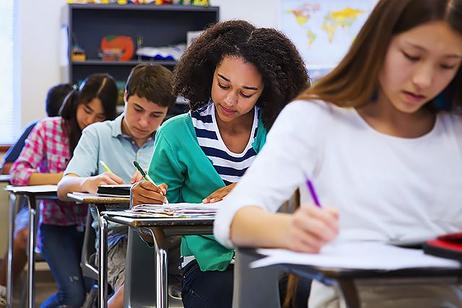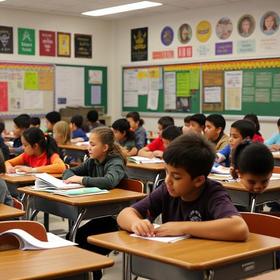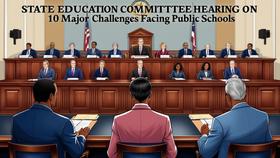The American public school system has shown a steady rise in the number of enrolled students since the beginning of this century. According to the National Center for Education Statistics, 47.7 million students attended public schools in 2001, a number that increased to 49.5 million by 2011. By 2023 the public school population is projected to be over 52 million students.

Not only is the overall student population growing, but its ethnic makeup is also shifting as well. As shown in the graph at right, as the number of white public school students has decreased, the number of minority students has rapidly increased, especially students who identify as Hispanic. In fact, by 2023, white students will comprise just 45 percent of public school students nationwide, while Hispanic students will represent 30 percent.
Educational Disparities Follow Racial and Ethnic Lines
As the student population in the United States continues to become more and more diverse, it becomes evident that students of color are often shortchanged because schools are inadequately prepared to educate children of various cultural and ethnic backgrounds. Particularly in the West and the South, where population growth has been explosive, public schools are struggling to provide services to children who have little or no English speaking abilities. Furthermore, since poverty disproportionately impacts children of color, districts additionally struggle to finance free and reduced lunch programs, before and after school academic support, additional classroom personnel, and other services necessary to bring these kids up to the grade-level performance.
This TEDTalk looks at the issue of diversity in our schools.
Not Enough Minority Teachers
Compounding the issue is that the vast majority – 82 percent – of American public school teachers are white. In 2012, just eight percent of teachers were Hispanic, seven percent were black, and 2 percent were Asian. The National Education Association (NEA) has labeled this situation a “diversity gap,” and points to this gap as one of many issues that negatively impact the performance of minority students.
To address the situation, the Center for American Progress has proposed a multi-pronged approach to attracting and retaining more minority teachers. Among their recommendations is increased federal oversight of teacher preparation programs to ensure graduates – minority or otherwise – are fully prepared to take on the rigors of teaching. Additionally, the Center advocates for improved state-level funding for teacher education programs, as well as strengthened federal financial aid programs for low-income students entering the teaching field.
Benefits of a Diverse Teaching Corps
Those in the education sector point out that an excellent way to motivate students to achieve to their fullest ability is to see someone like himself or herself standing in the front of the classroom. By increasing the number of teachers of color, minority students have that success story available to them – someone, they can look up to who shares a similar ethnic or cultural background. Additionally, research has shown that minority students respond better academically to minority teachers. Teachers of color may be more likely to incorporate culturally specific materials into their teaching that is familiar to minority students, which makes learning more relevant and therefore more fun. Minority students may also put more trust in, and have more respect for, a teacher with whom they share some significant characteristics, such as race. Data from studies in the 1980s demonstrate this fact: black children taught by black teachers scored four to five percentile points higher on measures of math and reading than black children taught by white teachers.
Minority students who are taught by a white teacher may also face what is known as a “stereotype threat.” Stereotype threat can occur when a student of color perceives their teacher to hold racially or culturally specific stereotypes against them. For example, a Hispanic student learning English may feel as though a white teacher holds diminished expectations for them in English class. Teachers may also hold unintentional biases when interacting with minority students. Studies show that teachers devote more class time and interact with students of their own race more so than with students who are not. Other studies have demonstrated that black students receive less praise and are more often punished than white students when the classroom teacher is white. Having a more diverse pool of teachers may help diminish these phenomena.
This video from Yahoo Finance discusses how students benefit from a diverse teaching staff.
Drawbacks of Focusing on Teachers’ Race
Many factors are involved in the success of a teacher-student relationship. Although race is certainly a factor, many in the education field maintain that the most significant in-school factor that determines student success is the quality of the teacher. According to Rand Education, a teacher’s effectiveness is not a function of their background, where they went to school, or how many years of experience they have. Rather, teacher effectiveness is dependent upon their on-the-job performance: what they do in the classroom and how they do it greatly impacts student achievement. In fact, recent studies show that effective teachers remain effective even when moving to a new school and regardless of the advantages or disadvantages the new school might have.
Many white teachers are fully capable – and highly successful – in educating minority students. The same holds true for minority teachers with white students. To focus solely on teacher race as a determining factor for student success ignores many other more important issues facing minority students. Non-school factors such as socioeconomic status, education level of parents, and parental involvement are highly influential on a child’s school achievement. In fact, research conducted by Rand Education shows that individual and family characteristics are four to eight times more likely to determine how successful a child is in school. A child can have a same-group minority teacher who cares deeply for them and works hard to educate them to the best of their ability, but if the child’s home life is in chaos if their parents are too poor to afford health care if their parents don’t read to them and help them with their homework, that child is at much greater risk for academic failure. As Richard Rothstein, a reporter with the Economic Policy Institute states, “good teachers alone, for most children, cannot fully compensate for the disadvantages many children bring to school.”
What is revealed, then, is a myriad of issues that need to be addressed if children of all racial backgrounds are to get the maximum benefit out of public education. Encouraging minorities to become teachers, stepping up recruiting efforts for minority teachers, and implementing retention programs to keep minorities in the classroom are all excellent steps toward improving the American educational system. The NEA has further proposed increasing teacher salaries, improving English language learner programs, enhancing and encouraging more parental involvement, and strengthening relationships with organizations that represent minority groups as solutions to the achievement gap problem. However, many more fixes are needed both in and out of the school system if a substantial difference in minority student achievement is to be made a reality.
Questions? Contact us on Facebook. @publicschoolreview












